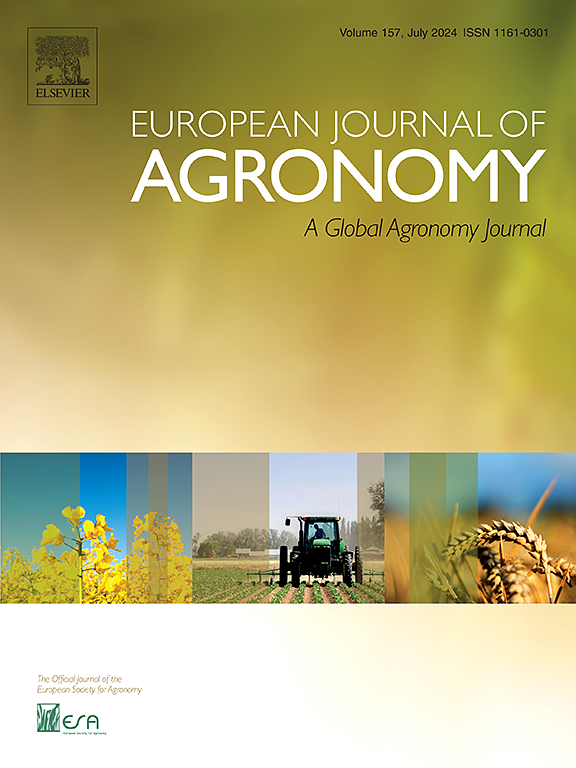Long term analysis on Olive flowering and climatic relationships in central Italy
IF 4.5
1区 农林科学
Q1 AGRONOMY
引用次数: 0
Abstract
The study aim was to analyze and interpret long-term trends in temperature and olive reproductive features, including full flowering dates and daily pollen concentrations, in central Italy. A 40-year database (1982–2022) of pollen and temperature records was utilized. Temperature changes significantly affect spring phenology and olive trees, sensitive to climate change, exhibit earlier flowering in response to higher spring temperatures. Although this adaptation may lower pollen levels, benefiting public health, it could negatively impact agricultural yields. Olive trees in the study area demonstrated phenological plasticity, transitioning from rigid to flexible flowering behaviors. They adjusted the Growing Degree Days (GDDs) required for flowering once they reached a threshold of maximum advancement. Until 2004, the trees accumulated similar GDD values. With rising temperatures, earlier flowering occurred at fixed GDD values of 650 and 750. Subsequently, the trees began accumulating higher GDD values, stabilizing the flowering date and preventing further advances. This phenological plasticity allows olive trees to adapt their life cycle and developmental stages to environmental changes such as temperature, light, and water availability. This flexibility helps them survive in changing conditions and prevents excessively early flowering. By avoiding flower opening and pollen release during periods of unstable weather (such as late spring rainfall and strong winds), the trees enhance pollen transport and successful pollination.
意大利中部橄榄开花与气候关系的长期分析
该研究旨在分析和解释意大利中部气温和橄榄繁殖特征的长期趋势,包括盛花期和日花粉浓度。研究利用了一个长达 40 年(1982-2022 年)的花粉和温度记录数据库。温度变化对春季物候有很大影响,对气候变化敏感的橄榄树会提前开花,以应对春季温度升高。虽然这种适应可能会降低花粉含量,有利于公众健康,但可能会对农业产量产生负面影响。研究地区的橄榄树表现出物候可塑性,从刚性开花行为过渡到柔性开花行为。一旦达到最大提前量的临界值,它们就会调整开花所需的生长度日(GDDs)。在2004年之前,树木积累了相似的GDD值。随着温度的升高,在固定的 GDD 值为 650 和 750 时,花期提前。随后,橄榄树开始积累更高的 GDD 值,从而稳定了花期,并阻止了花期的进一步提前。这种物候可塑性使橄榄树能够根据温度、光照和水分供应等环境变化调整其生命周期和发育阶段。这种灵活性有助于它们在不断变化的环境中生存,并防止过早开花。通过避免在天气不稳定期间(如晚春降雨和强风)开放花朵和释放花粉,橄榄树可提高花粉运输和授粉成功率。
本文章由计算机程序翻译,如有差异,请以英文原文为准。
求助全文
约1分钟内获得全文
求助全文
来源期刊

European Journal of Agronomy
农林科学-农艺学
CiteScore
8.30
自引率
7.70%
发文量
187
审稿时长
4.5 months
期刊介绍:
The European Journal of Agronomy, the official journal of the European Society for Agronomy, publishes original research papers reporting experimental and theoretical contributions to field-based agronomy and crop science. The journal will consider research at the field level for agricultural, horticultural and tree crops, that uses comprehensive and explanatory approaches. The EJA covers the following topics:
crop physiology
crop production and management including irrigation, fertilization and soil management
agroclimatology and modelling
plant-soil relationships
crop quality and post-harvest physiology
farming and cropping systems
agroecosystems and the environment
crop-weed interactions and management
organic farming
horticultural crops
papers from the European Society for Agronomy bi-annual meetings
In determining the suitability of submitted articles for publication, particular scrutiny is placed on the degree of novelty and significance of the research and the extent to which it adds to existing knowledge in agronomy.
 求助内容:
求助内容: 应助结果提醒方式:
应助结果提醒方式:


